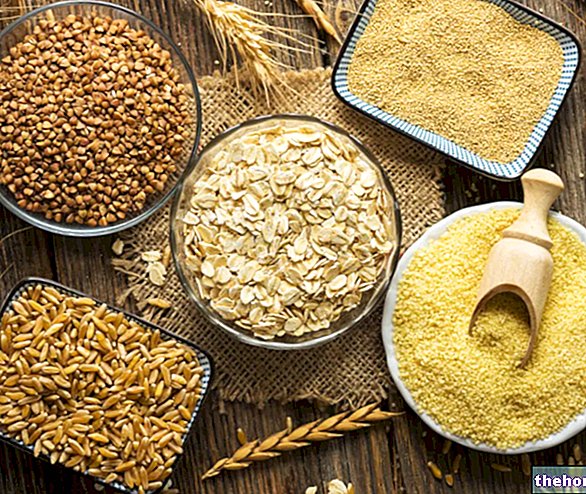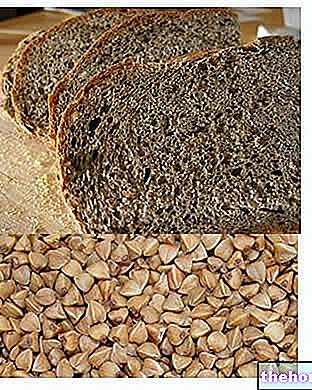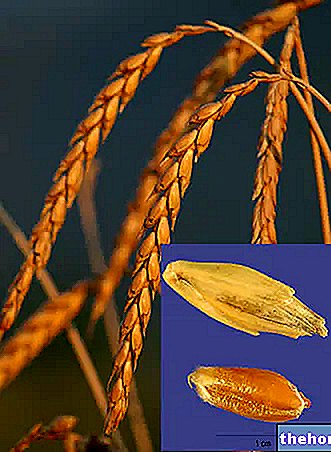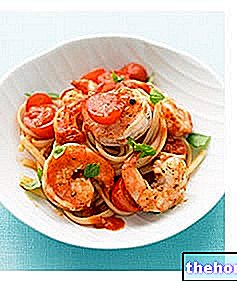Definition and Foods rich in bran
Bran is a kind of fibrous shell that covers the seeds of wheat and other cereals. After being separated from the flour, according to a process called refining, it comes in the form of more or less wide and distinct flakes.
Until the early 1970s, bran was considered a waste product, to be used mainly for feeding livestock.

Since the seventies dietary fiber has attracted more and more the interest of nutritionists, thanks to its ability to prevent many diseases typical of the wellness society (constipation, obesity, irritable bowel, colon cancer, etc.).
Wheat bran is preferable to other types in case of constipation, both in terms of quantity and quality. It is richer in insoluble fibers, which give it the ability to swell, absorbing water up to 400% compared to its weight. In the case of diabetes, diverticulosis or hypercholesterolemia, the food sources richer in soluble fiber are preferred.
Benefits and properties of bran
- It facilitates intestinal transit: the bran performs a "softening, massifying and homogenizing action of the stool, increasing the motility of the colon and reducing the pressure on the intestinal walls. This property is particularly beneficial in the prevention of diverticulosis and colon cancer (the fiber facilitates the elimination of toxic residues introduced with food). The laxative effect is all the more pronounced the more the bran is rich in insoluble components.
- It counteracts overeating: swelling in the stomach causes an anticipated sense of satiety, which prevents the ingestion of excessive quantities of food. Fiber has a limited caloric intake, practically nil if we consider the reduced intestinal absorption of the nutrients it is associated with.Bran is therefore useful for combating overweight and obesity.
- Modulates the absorption of nutrients: thanks to its ability to reduce the absorption of fats and cholesterol, bran is particularly important in the diet of those suffering from hypercholesterolemia or a high rate of triglycerides in the blood. Furthermore, by modulating the glycemic curve , helps to avoid excessive increases in blood sugar and is therefore indicated in the prevention of senile diabetes.
The integration of bran, in the order of 8-24 g per day (1-3 tablespoons), accompanied by at least two liters of liquids, is therefore indicated in case of constipation, irritable bowel, diverticular disease, diabetes, dyslipidemia, overweight and obesity.
Initially, the intake of bran is accompanied by undesirable effects such as distension and excessive flatulence, however these problems tend to regress within 4-6 weeks. To counter these unpleasant ailments it is necessary to gradually increase the doses and divide them into different times of the day.
Disadvantages and contraindications
The supplements and pharmaceutical preparations based on fibers are now very many, so much so that the old bran is often associated with other natural massifying agents of the faeces, such as glucomannans, agar agar or karaja gum.
Rather than using these products, it would be better to regulate one's eating habits by increasing the intake of fruit and vegetables. It is clear that the simple addition of fiber supplements is not comparable to the benefits of a diet naturally rich in these substances.
If the cereal from which the bran is extracted is not of biological origin, the risk of ingesting the synthetic chemical agents that are normally removed together with it, is high.
Prolonged use of bran can also lead to a depletion of vitamins and mineral salts, interfering with the absorption of calcium, iron, phosphorus and zinc.
Finally, it is necessary to consider the individual tolerance to the consumption of bran. Its use can in fact increase the production of intestinal gas, causing bloating and an annoying sense of relaxation. The bacterial degradation of its components can thus aggravate some forms of colitis or worsen irritable bowel syndrome and the symptoms of meteorism.
Rather than resorting to indiscriminate use of bran, it is better to rely on a varied diet, gradually increasing the presence of fiber, through the regular consumption of fruit, vegetables and whole grains, which contain both bran and vitamins and minerals necessary for your well-being.
Bran is therefore not a panacea but a useful supplement to be used only in special cases, after consulting a doctor or other professionals in the sector.
Other Cereals and Derivatives Amaranth Wheat starch Corn starch Rice starch Modified starch Oat starch Bulgur Whole grains Corn Flakes Crackers Oat bran Bran Cus cus Amaranth flour Oat flour Buratto flour Spelled flour Buckwheat flour Corn flour Corn flour Millet Barley flour Quinoa flour Small spelled flour (Enkir) Rice flour Rye flour Sorghum flour Flour and semolina Whole wheat flour Manitoba flour Pizza flour Spelled Rusks Focaccia Nuts Wheat or wheat Wheat germ Burnt wheat Buckwheat Breadsticks Oat milk Rice milk Corn Maizena Malt Millet Muesli Barley Stale bread Unleavened bread and Pita Bread Carasau bread Egg pasta Rice pasta Wholemeal pasta Piadina Small spelled Pizza Pop corn Baked goods Quinoa Rice Basmati rice Converted rice White rice Rice Wholemeal Parboiled Rice Puffed Rice Venus Rice Rye and Horned Rye Semolina Semolina Sorghum Spaghetti Spelled Teff Tigelle Triticale OTHER ARTICLES CEREALS AND DERIVATIVES Categories Food Alcoholics Meat Cereals and derivatives Sweeteners Sweets Offal Fruit Dried fruit Milk and derivatives Legumes Oils and fats Fish and fishery products Salami Spices Vegetables Health recipes Appetizers Bread, Pizza and Brioche First courses Second courses Vegetables and Salads Sweets and Desserts Ice creams and sorbets Syrups, liqueurs and grappas Basic Preparations ---- In the Kitchen with Leftovers Carnival Recipes Christmas Recipes Dietary Recipes Light Recipes Woman's Day, Mother's Day, Dad's Day Functional Recipes International Recipes Easter Recipes Recipes for Celiacs Recipes for Diabetics Holiday Recipes Valentine's Day Recipes Vegetarian Recipes Protein Recipes Regional Recipes Vegan Recipes
















.jpg)











